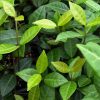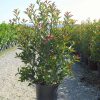Planting Trees & Shrubs in North Texas
Planting your trees and landscape shrubs right can make all the difference. Following a few important tips during the planting process can assure that your plants are ready to survive the heat and thrive for years to come! Planting your tree or shrub right is only half the battle, make sure you pick plants that are both heat and drought tolerant and have the ability to perform well in our alkaline and clay soils. Once you decide on a suitable tree or shrub for the conditions in your yard keep these tips in mind when planting and caring for new additions to your landscape.
Container Grown vs Balled & Burlap
Container grown Trees and Shrubs can be planted year round and have a number of benefits over field dug bald and burlap trees. Plants grown in containers have a complete root system and therefore transplant better and once planted are able to establish healthy root systems quickly. With container grown trees there should be very minimal transplant shock and no concern for initial die back from loss of root system. Container grown plants can be planted immediately or held back until the planting site has been prepped or determined. Balled and burlap (B&B) plants are better suited for planting during the fall or winter months due to the loss of root system while being dug. B&B plants lose up to 50% of their root system during the digging process and can lead to slow initial grown and a heightened risk of loss. The Plant Shed only stocks container grown trees, but can obtain B&B trees on request for larger trees at discounted prices.
Planting Site:
When choosing the planting site make sure there is adequate space available for mature growth horizontally as well as vertically. Choose the right plant for the right spot. Trees and Shrubs planted in areas that are too small will not flourish and will eventually suffer and die. Root systems will require as much space under the ground as the tree/shrub would require in the air so make sure not to keep this in mind when selecting your planting site.
Site Prep:
Once you’ve decided on the perfect spot its time to dig the hole. The hole should be at least 2 times the width of the root ball out of the container. For large Trees or Shrubs its best to allow the top of the root ball to set above the soil line about 2 inches higher than in the original container, this allows the root ball to settle as it matures. This will keep the plant from becoming buried too deep witch can suffocate the plant and cause immediate death. For smaller plants the depth should be no deeper than the original root ball from the container.
Planting Done Right:
1.) Remove the Tree or Shrub from the container.
2.) Lightly loosen and separate the roots, this helps to encourage the roots to grow in a natural direction instead of the circular pattern that it has been use too.
3.) Place the plant into the hole and back fill with Native soil. In some cases where the soil is too poor to reuse, a mix of half Native soil and half landscape mix can be used.
4.) Make sure that the root ball is completely covered.
5.) Afterwards water the root ball to help eliminate any air pockets that may have formed during the planting process
6.) Add 2 to 3 inches of your favorite mulch around the root ball to help to keep the weeds down and the moisture level up.
7.) Water each plant thoroughly after planting.
Watering:
Watering is key to the success of any landscape project big or small. Newly planted Trees and Shrubs require a minimal amount of water to survive. Watering frequently and for short periods of time can cause the plant to be dependent on more water therefore creating an unhealthy plant that needs to be watered more often. This actually causes the plant to produces a shallow root system that is less aggressive and requires more care. Watering deeply and infrequently helps to promote a deeper healthier root system witch in return means less watering as the plant matures. Watering in this way also helps strengthen the plant structure making it less susceptible to insects, disease, drought and excessive heat and cold. With summer coming, water restrictions are probably not far behind; watering by hand seems to be more acceptable than traditional methods. This can make watering a challenge but watering deeply and less frequently seems to be more acceptable to the plants as well as the city governments…



